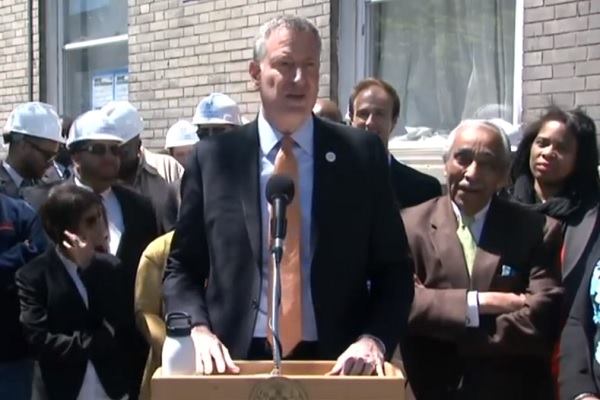Does anybody care about the quality of housing? Apparently not, or at least not in New York. How and where you live is only a numbers game, as Mayor Bill de Blasio’s announcement of a plan to “spend” up to $40 billion to create “affordable” housing in the city makes clear.
De Blasio and his team actually assume that they will attract about 75 percent of that $40 billion from private development, and a majority of the rest of it will come from existing state and federal funds. The latter will mainly pay for subsidizing those who truly cannot afford to live in New York anymore, including the elderly, and for rehabilitation of existing buildings. The biggest trick of the plan is that the mayor wants to make the inclusion of “affordable” housing mandatory for any large-scale development. He already forced the Domino development, around the factory of that name in Brooklyn, to add more such units in return for building their colossal (and architecturally, moderately interesting) new neighborhood looking out at Manhattan’s crystal spires.
In return, de Blasio wants to make it easier to get a building off the ground in the city. The problem is that—as Curbed and New York Magazine stated in their takeaways of the plan—his council does not want to give up the power to stop or promote developments in their district, while the difficult issues of how to change the rules and regulations will now be picked up by a committee that at some time, maybe, will make recommendations.
As far as I can tell—and I admit to not having read the 116-page plan with a loupe—it is all hot air that formalizes the idea that New York wants to keep building more cookie-cutter apartment and condo towers, differentiated by height and somewhat by size, as well as by location. The closer to 57th and 5th Avenue and the higher up you are, the more expensive your living space. Other than views and location, though, there is nothing about the new or proposed developments to differentiate them. Mayor de Blasio just wants to mass produce more cells for as many people as possible.
It is doubtful whether de Blasio will have any success with this plan. Not only does he have to get developers to step up to the plate, but he has to give them room, and you know that neighbors and their representatives will be raring for a fight about anything tall and big next to their existing cells.
I would argue that the better solution would be to ask architects and others to come up with alternative models that might let New York develop in a denser, more integrated, and more sensible manner. Perhaps his predecessor’s commissioning of ideas about how to confront climate change through design might be a model. Let’s not forget that this is the city that came up with and legislated the “dumbbell tenement” to ensure that at least some light and air entered into the middle of apartments. This is also the city that produced marvels such as the London Terrace Gardens, a block-sized apartment development surrounding generous shared outdoor space. Even modernist enclaves such as Stuyvesant Town and Peter Cooper Village have proven to be durable alternatives to cramped blocks. More recently, the much-maligned original plan for Atlantic Yards would have created differentiated living conditions that mixed different forms, uses, and income levels in a dense, but striking new community. The current plan, though innovative in its modular construction, will just add more boxes.
It is not just a problem, in other words, of making space for the poor in New York. It is a case of looking at the ways in which space is arranged and used throughout the City, and coming up with ways to create a more pleasant living and working environment. There are models for that around the world, and there are ways in which it could be accomplished. All it needs is a political look at physical reality, not abstract social agendas.
Aaron Betsky is a regularly featured columnist whose stories appear on this website each week. His views and conclusions are not necessarily those of ARCHITECT magazine nor of the American Institute of Architects.
Second image used with permission via a Creative Commons license with Flickr user Dan DeLuca
